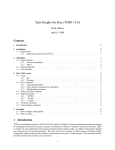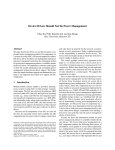Download User Guide for ARTS
Transcript
User Guide for ARTS System-on-Chip Group Technical University of Denmark 1. INTRODUCTION This document is targeted for the users of the system-level multiprocessor system-on-chip (MPSoC) simulation framework, called ARTS, developed at the Technical University of Denmark (DTU). The framework allows to: · model processing elements (PE), memory units and interconnect, · investigate PE utilization, memory usage, communication issues, and energy/power consumption, and · analyze the causality between MPSoC components i.e. resource constrains and interdependencies This document explains the various aspects relating to the use of the SystemC [SystemC 2002] implementation of the ARTS framework. The latest version of the framework can be found at: ☛ http://www.imm.dtu.dk/arts Before proceeding further, we explain some of the conventions used in this document. The symbol ☛ marks an important information. Text presented in a box mark user action such as entry at the command prompt. Further we assume the operating environment to be linux-like platform. This document is organized as follows. First, in Section 2, some details about the ARTS executable is provided. This is followed by the description of the inputs expected by this executable (Section 3). A successful simulation of the given problem, results in a collection of files for analysis, which are explained in Section 4. Finally a brief, Section 5 walks the reader through using the ARTS model. 2. THE EXECUTABLE AND SUPPORT FILES Depending on the platform choose, the executable is named: arts_<platform>.x. In a unique folder, download the version best suited to your conditions. Along with the executable, a support_files.tar.gz should also be acquired and saved in the same location as the executable. The files within this bundle are used in the running example within the document and are necessary to complete the tutorial. The first test is simply to issue the command to run the executable. $> ./arts_<platform>.x Figure 1 should be the outcome. It implies that additional arguments are needed to be set, Document version: 1.0. Drafted on September 2005. Address: Technical University of Denmark, Informatics and Mathematical Modelling, Richard Petersens Plads, Building 321, DK-2800 Lyngby, Denmark. Contact email: Shankar Mahadevan ([email protected]) © 2005 Technical University of Denmark 2 · Technical Uinversity of Denmark =============================================================== ARTS SoC Modelling Framework Copyright (C) 2005 Department of Informatics and Mathematical Modelling, DTU =============================================================== Please check the arguments to the executable: ./arts_<platform>.x -app <path>/<filename>.tg <path>/<filename>.tg -rsc <path>/<filename>.rsc <path>/<filename>.rsc -cmm <path>/<filename>.cmm -prt <path>/<filename>.prt <ocpConfig_file> <num of PE> exectime Fig. 1. Arguments required with the ARTS executable. Argument Flag -app Arguments 1 or more .tg files -rsc -cmm -prt 1 or more .rsc files 1 or more .cmm files only 1 .prt file <ocpConfig_file> <num_of_PE> execttime only 1 file 0 to ∞ 0 to ∞ Comments this takes one or more file(s) describing the applications task graphs this takes one or more file(s) describing the PE characteristics this takes the communication description this takes one file that describes the architecture i.e. PE with the interconnect, and the mapping of the tasks on to the PEs this is one file describing the OCP signal configuration the number of PEs in the architecture the cycles to be simulated Table I. Expected arguments for the ARTS executable. to operate the executable. Note any other outcome implies an incompatibility between the executable and the underlying platform. The source code of the ARTS framework would need to be compiled on this platform to proceed further. The arguments of the executable and their meaning is explained in Table I. The five primary items: the application, PE, communication, and architecture/mapping and OCP configuration file will be discussed in detail in the next section. The remaining items related to prescribing the number of PE in the architecture and the number of cycles to simulate. Unpacking the support files bundle will provide the necessary argument files for demonstration of the ARTS framework. Figure 2 is one of the simple possible complete command to run the simulation. The similarity of argument fields in this command, and in Table I and Figure 1 are obvious. A successful simulation will have the Simulation end time (last few lines in display) equal to given number of cycles to simulate, followed by simulation time statistics. The output of a successful simulation is also a collection of log files. Before we explain the contents of the output files, as done in Section 4, let us take a closer look at the input argument files. 3. UNDERSTANDING THE INPUTS The primary inputs to the ARTS framework are ASCII files describing the application model (.tg extension), the PE characteristics (.rsc extension), the communication properties (.cmm extension) and the architecture with the application tasks mapping (.prt extension). First, we provide a brief overview of the application, PE and communication files. For additional details on these files, we the refer the reader to [Schmitz et al. 2004]. Then, · User Guide for ARTS 3 $> ./arts_<platform>.x -app ./support_files/apps/sample1.tg ./support_files/apps/sample2.tg -rsc ./support_files/rsc/GPP0.rsc ./support_files/rsc/ASIC0.rsc -cmm ./support_files/cmm/COMM.rsc -prt ./support_files/prt/sample.prt ./support_files/ocp 2 30000 Fig. 2. Sample Simulation Command # THIS IS SAMPLE TASK GRAPH ! HYPERPERIOD 0.025 TOLERABLE_TIMING_PENALTY 1.0 # 1.2 is 20% variation # in execution time τ0 τ1 τ2 τ3 τ4 Task: Task: Task: Task: Task: (00) (01) (02) (03) (04) ttype: ttype: ttype: ttype: ttype: Edge: Edge: Edge: Edge: Edge: (00) (01) (01) (02) (03) –> –> –> –> –> 4 2 3 3 0 epst: epst: epst: epst: epst: (01) (02) (03) (04) (04) 0 0 0 0 0 dtype: dtype: dtype: dtype: dtype: etype: etype: etype: etype: etype: NON NON NON NON NON Deadline: Deadline: Deadline: Deadline: Deadline: 0 0 0 0 0.025 2 2 4 1 0 Fig. 3. Sample Task Graph Fig. 4. File description of a task graph (.tg file), say sample.tg. we describe our architecture description and application task mapping file. Table 21 in Appendix A spells out the meanings of the labels used in these files. 3.1 Application (.tg) Characterizations We consider the applications to be modelled as a task graph G = (T , E), where T = {τi : 1 ≤ i ≤ n} is the set of schedulable tasks, and E = {ej : 1 ≤ j ≤ k} is the set of directed edges representing the data dependencies (precedence constraints) between the tasks in T , i.e., if τi ≺ τj then (τi , τj ) ∈ E. Figure 3 shows a sample task graph with five tasks and five edges. The weight of an edge indicates the size of the message to be transferred between two tasks. Each task τi ∈ T is characterized by a four tuple hdi , ti , ci , ei i, i.e. the exact functionality of the task is abstracted away. The relative deadline, di , and the period, ti , are given by external requirements of the application and, hence, are independent of runtime input values, intermediate results or configurations of PE cores. However, the execution time, ci , and the consumed energy, ei , are both determined by the actual mapping of the task onto a particular PE. The deadline of a real-time application, DT , is represented by the deadline of the task(s) in T with no successors, i.e. no outgoing edges. The concurrent execution of several realtime applications, each with their own deadline and period, is handle as a set of task graphs which have to be mapped onto the platform architecture. Figure 4 is the file description, a .tg file, of the sample task graph shown in Figure 3. Lines starting with # are comments, which continue until the end of the line. The period 4 · Technical Uinversity of Denmark # THIS IS THE TECHNOLOGY FILE @GPP 0 { # Price StPwr 100 800 # ttype 0 1 2 3 4 .. .. } Version 0 0 0 0 0 Freq 25000 CommBuffer 1 CommTime 0.271247 CommPower 2000 CommMem 13 ExeCyc 2882 200 100 981 395 DynPwr 25000 25000 25000 25000 25000 StMem 400 400 400 400 400 DynMem 400 400 400 400 400 Preem 1 1 1 1 1 Exable 1 1 1 1 1 Fig. 5. File description of PE (.rsc file). and the deadline, the PE-independent tuples, can be easily recognized via the values of HYPERPERIOD and by looking at the end task, respectively. The values are given in seconds, which for this sample task graph is identical and equal to 0.025 s. With regards to variations in the execution time, ci , in order to calculate the worst-case execution time we use the value of keyword TOLERABLE_TIMING_PENALTY. In this case, Figure 3, the worst-case execution characteristics is expected to be same. Within the file, the task graph is described via task description and edge description separately, in that order. In Figure 4, each line starting with Task: uniquely identifies a task within the task graph. In addition to task identifier, the bracketed item, each task has a task type (ttype). The task type is used to apply the PE-specific tuples such as execution time and energy consumption, when bounding this task to a particular PE. This affords flexibility during instantiation as changing the underlying PE does not need manipulation of the application files, but simply applying the new values of this task type from the PE database. This will be described in additional detail in the next section. In addition to the four tuples, two additional variables epst: (earliest possible start time) and dtype: (deadline type, i.e. NON, SOFT, and HARD) are also available for future use. The default value, accepted by the current version of the ARTS framework is displayed in the figure. Each line starting with Edge: uniquely identifies an edge between two task, and the direction of their interdependency, within the task graph. One task may have many outgoing and incoming edges, but each edge needs to be identified separately. Similar to task type, edge type (etype) is used to apply the message transfer characteristics depending on the particular communication means. 3.2 PE (.rsc) files ARTS supports many PE types. The built-in PEs are general purpose processors (GPP), FPGAs and ASICs. A sample PE description of GPP is shown in Figure 5. The IP type of the PE is given by line starting with @. Each file should have unique IP type. Multiple PE of the same type can be tagged with additional numeric value, for example @GPP 0, as shown in the figure. The PE properties are encapsulated in opening and closing brackets ({ and }). Within the file, first the task-independent properties are described, followed by the task properties. User Guide for ARTS · 5 @COMM_AMOUNT 0 { # etype comamount 0 16 1 330 2 320 3 36 4 16 } Fig. 6. A Sample Communication description in .cmm file. The PE’s task-independent properties are listed as items starting with price, static power (StPwr), operating frequency (freq), etc. The PE’s task properties include number of clock cycles required for execution (ExeCyc), dynamic power dissipation (DynPwr), memory requirements, etc. In addition to these properties, other ASIC and FGPA related items such as area and CLBs, respectively, required to implement the task is also available (See Table 21 in Appendix A. Also ASIC0.rsc file in support_file/rsc). The PE’s task properties are listed next. When a task from the task graphs is mapped to a particular PE, the task properties can be extracted by looking up the index of the ttype in the .tg file and matching it with the task type in .rsc file. Correlating the data given in Figure 4 and Figure 5, it is seen, for example, that task (0 1) in the task graph requires 100 cycles for execution in GPP0, and so on. The ARTS framework, automatically correlates these values, using the architecture and the mapping described in the .prt file, which is discussed later. 3.3 Interconnect (.cmm) files Within ARTS, the message size is described in the .cmm file. Similar to .rsc files the communication properties is described within closing brackets ({ and }). By correlation between the etype described in the task graph, with the appropriated index, the message size to be transferred for a given edge can be calculate. Correlating the data given in Figure 4 and Figure 6, it is seen, for example, that the edge between the task (0 1) and (0 3) requires the 16 words of data units. Using these three files, the MPSoC designer can influence the properties of the application, PE and communication for any architecture instantiated within the ARTS framework. The designer is not limited to the built-in templates. Any application, PE or communication data conforming to the file semantics can be used as inputs to instantiate a custom platform. 3.4 Architecture (.prt) files The architecture file describes the MPSoC modules such as the PEs and the interconnect, and the mapping of the task from the task graph on to these PEs. In addition to this primary purpose, the file also contains the frameworks simulation controls such as display of debug messages and monitoring system parameters. Figure 7 shows a sample architecture file. The file can be distinguished into five parts. The first two parts, which are optional, relate to enabling simulations items such as dumping the PE, application or communication events on the screen, or capturing these values in a file. Additional parameters PE utilization, communication and/or memory pro- 6 · Technical Uinversity of Denmark # — On-screen Simulator debug message (0=off, 1=on) pe_screen_dump =0 # dump PE events soc_screen_dump =0 # dump communication events # — Enable output logging via files (provide unique filename, no spaces) app_logfile = "app.log" # stores application events pe_logfile = "pe.log" # stores PE utilization result_file = "result.log" # stores architecture overview memory_file = "mem.log" # stores memory profile contention_file = "comm.log" # stores communication profile vcd_file = "sim" # default extension .vcd # Communication description module { # — Communication topology (0=bus, 1=mesh) soc_comm_topology # communication keyword soc_allocator =0 # bus } # PE description module { # — configuration for PE#0 peID =0 # unique processor identifier address = 0x0000000:0x0fffffc processor =0 # processor type, see rsc argument synchronizer =0 # synchronizer type resource_allocator =0 # allocator type scheduler =0 # scheduler type monitor =0 # specific PE debug msg dump PE#0 } module { # — configuration for PE#1 peID =1 PE#1 address = 0x1000000:0x1fffffc processor =1 # match index with rsc argument synchronizer =0 # 0=direct synchronization resource_allocator =0 # 0=basic priority inheritance Fig. 8. Sample Architecture scheduler =0 # 0=RM, 1=EDF monitor =0 # 0=off, 1=on } # Mapping of task from .tg files to PE application { # <taskID>,<peID> mapping name: "sample.tg" # identify using .tg filename task: 1, 0 # task (0 0) mapped to PE#0 task: 2, 1 # task (0 1) mapped to PE#1 task: 3, 0 # .. so on. task: 4, 1 task: 5, 0 } application { name: "sample2.tg" # another sample application task: 1, 0 task: 2, 1 task: 3, 0 task: 4, 1 task: 5, 1 task: 6, 1 } Fig. 7. A Sample Architecture description in .prt file. User Guide for ARTS · 7 file can also be captured in spreadsheet-friendly format via providing a filename to the appropriated keywords (no space within the filenames). These files are explained in next section. To disable logging of any specific event, simply comment out the appropriate keyword. This may led to smaller simulation time as well. The next two part describe the architecture, where each component is described at module. The module descriptions starts with the interconnect, which is identified by keyword soc_comm_topology as the communication module. The topology is identified by another keyword soc_allocator, which takes a numeric value identifying bus or multi-hop network interconnect. The remaining module characterize the PE that use this interconnect. In the case of Figure 7, we have two PEs, each identified by a unique ID (peID) and memory space (address). Following these declaration, are five parameters: processor, synchronizer, resource_allocator, scheduler, and monitor; that are used to assign execution and OS characteristics to this PE. The processor can have values equal to the index of the rsc argument (see Table I). Comparing the architecture file in Figure 7 and the sample simulation command in Figure 2, for this example: PE#0 is of type GPP0 and PE#1 is of type ASIC0. This allows easy replacement of the PE execution characteristics: either via the architecture file or at the command line. The final keyword, monitor, can be used to display the PE’s events on the screen when the primary simulation pe_screen_dump is off, thereby allowing monitoring/debugging of individual PE activities. The synchronizer, resource_allocator, and scheduler keywords take numeric index of corresponding built-in ARTS synchronizer, resource allocator and scheduler, respectively. Within the ARTS, the user can apply Direct Synchronization (index 0) for the task synchronization, basic priority inheritance (index 0) for the resource allocation, and Rate Monotonic (RM) (index 0) and Earlier Deadline First (EDF) (index 1) for the task scheduling. Additional built-in OS components can be coded easily using the available features in the source code, however are currently unavailable with the ARTS binary. Together, all module descriptions, enable visualizing the architecture. figure 8 represent the architecture described in Figure 7. Any number of modules can be instantiated to realize a custom architecture. The final part of the architecture file is the application mapping i.e. prescribing which tasks are mapped to which modules. Mapping has to be described for each application separately and it is done within the application group (enclosed within { and }). The application can be identified using the name, which should have a corresponding filename associated with the app argument (see Table I) of the executable. Further, the number of tasks defined in the application block should match the number of tasks in the prescribed application task graph file (.tg file). To begin mapping, each line has to start with keyword task: followed by the pairing of the task index and the PE index i.e. the peID. ☛ Note the task index have to be offset by one. This is legacy code requirements and will be fixed in future versions of the ARTS release. In our running example, comparing the Figures 4, Figure 7 and Figure 8, for the sample application (filename: sample.tg) the tasks are alternately mapped to PE#0 and PE#1. As seen for sample2.tg application, any mapping can be applied. In all, there are 11 tasks, 5 8 · Profile 0 Technical Uinversity of Denmark Task Count 11 PE0 GPP0 PE1 ASIC0 ET@app0 14931 us Deadline MET ET@app1 20694 us Deadline MET Total ET 20694 us Fig. 9. Architecture Overview file. tasks are mapped to PE#0 (GPP0) and 6 tasks are mapped to PE#1 (ASIC0). In addition to above three types of files, an OCP signal configuration files [OCPIP 2004] is required with the input arguments. It contains the OCP signals and their values used at the PE interface with the interconnect and follows the standard format available with OCP channel package described in related manual available from OCP website. Any error, for example: incorrect spelling, syntax errors, incorrect string and index values, reuse of unique keywords or values, mismatch between command string input and values, etc; are flagged during parsing of the input files and the simulation terminates immediately with appropriate message. Upon correct parsing of all the related inputs, the simulation can be successfully initiated by the ARTS framework. As previously discussed in Section 1, the support_files.tar.gz contains a sample of these input files for real application and PEs, and the command presented in Figure 2 can be used to execute the ARTS model. The output resulting from this and similar execution is discussed next. 4. UNDERSTANDING THE OUTPUTS Based on which events are enabled for recording (Figure 7) multiple spread-friendly files are generated that provide an overview of the architecture-under-test, and the profile of the application, the PE utilization, the memory or the communication. Consider the outputs for the simulation executed by command in Figure 2. The outputs file are illustrated in Figures 9 to Figure 14. For the architecture overview and the PE utilization files, each column has a single data item. Profile is the architecture identifier used internally in ARTS to tag different architectures. Here since, we only have one architecture for exploration the value is 0. The architecture overview file, Figure 9, can be used to confirm the inputs, such as task count and PE types. Additional data pertains to the completion time (end time (ET)) and the deadline status (MET or MISS) of individual applications is also provided here. The final two columns Total ET and Contention, provide the final completion time of the program (which should be equal to the application that finished last) and the interconnect contention count i.e. the count conflicting concurrent link access over the program execution. If the values in this file are satisfactory, further analysis of the rest of the output files may be undertaken. ☛ The ET of the application, is the completion time of the last invocation of the application. In the case, where the provided number of cycles of simulation (execttime argument) is significantly larger than anticipated program completion time or the period of the applications, the applications will be invoked multiple times and the completion time of the final invocation is recorded in the overview file. ☛ In the case that the provided number of cycles to simulate (execttime argument) is insufficient to finish program execution, 0 s is displayed for ET. Contention 0 User Guide for ARTS PE Utilization: Profile PEU0 0 75.6467 PEU1 23.8467 Fig. 10. PE Utilization file Communication Profile: Time Contention 1 0 1749 4 .. .. 12834 1 16049 0 Fig. 12. Dummy Communication Profile · 9 Application Profile: Platform Architecture 0 14931 ns Task graph sample1.tg (AppID 0) completed. 20694 ns Task graph sample2.tg (AppID 1) completed. Fig. 11. Application Profile file. Memory Profile: Platform Architecture 0 Time PE#0PM PE#0DM PE#0TM 1 2000 320 2320 1664 2000 576 2576 .. .. 20694 2000 0 2000 25001 2000 0 2000 .. .. 28631 2000 666 2666 PE#1PM 2400 2400 PE#1DM 0 0 PE#1TM 2400 2400 2400 2400 0 0 2400 2400 2400 0 2400 Fig. 13. Memory Profile file. In the PE utilization file, Figure 10, after Profile each subsequent column corresponds to PE utilization for individual PEs. This value is for the complete simulation time and may include PE execution cycles for multiple invocation of the applications. The application profile file, Figure 11, presents the status of application execution i.e. when they finish execution and if it met or missed its deadline. In the event of deadline miss, the task(s) missing the deadline is also reported. For memory and the communication profile, Figure 13 and Figure 12 (☛ dummy values unrelated to simulation of Figure 2), the data is formatted as column-row grid, which allows to plot the time vs memory (or contention). The first column is time in system cycles. For memory, subsequent columns plot the program memory (PM), the data memory (DM) and the total memory (TM) for each PE. For communication contention profile, the subsequent columns plot the total contention count (PE’s waiting for the bus or link to be free) in that cycle. ☛ Note that the memory and the contention values are plotted for the complete simulation (execttime argument). To evaluate the memory and/or contention correlations within any particular applications, the designer may wish to plot only upto the completion time (ET@app#<N>) of desired application. The VCD output file, Figure 14, profiles the task execution status and the PE execution of the tasks. First, it lists the tasks execution status, i.e. the time period when the task is ready (01), the time period the task is running (02), the time period if and when the task is suspended (03), and finally when the task is idle/finished (00). To associate the task marker (starting with 1_1 after the system clock) in the VCD file to the corresponding the application task, decode the value as task identifier and application identifier separated by the underscore (’_’) i.e. profile of 1_1 belongs task ID 1 of application ID 1. The application identifier corresponds to the order in which the application mapping is described in architecture (.prt) files. Thus, in our running example from Figure 7, sample.tg has application ID 1 as it is first in order for mapping. Thus VCD waveform of task marked from 1_1 to 5_1, are for sample.tg. The next set of task are marked for sample2.tg, which run from 1_2 to 7_2. 10 · Technical Uinversity of Denmark 0ns 500ns 1.0us 1.5us 2.0us 2.5us 3.0us 3.5us clock 1_1 02 2_1 01 02 3_1 01 02 4_1 01 02 5_1 1_2 01 03 02 PE0_taskID 1 -1 1 2_2 3_2 4_2 5_2 6_2 -1 3 PE0_appID 1 12 2 5 1 PE1_taskID 0 -1 2 -1 4 PE1_appID 0 5 1 12 1 Fig. 14. Sample VCD plot Following the task execution, the PE’s execution status is plotted in the VCD file. For each PE, two items are recorded: the task ID (PE<N>_taskID) and the application ID (PE<N>_appID) of the current task executing on the PE resources. The time-slot of a task execution should match with one and only one task with execution status of index 02 i.e. running. In Figure 14, we can see task executions of sample.tg, starting from task 1_1 on PE#0 until 1.65 us. The negative task IDs are communication tasks and do not correspond to any application ID (☛ dummy values, legacy ARTS behaviour). The communication task pairing (PE<N>_taskID, PE<N>_appID) = (−1, 12) corresponds to outgoing communication from that PE and the pairing (PE<N>_taskID, PE<N>_appID) = (−1, 5) corresponds to incoming communication. In Figure 14, we can observe communication between task 1_1 on PE#0 to tasks 2_1 starting at until 1.65 us and completing at 2.0 us. Note the task 2_1, which is scheduled for execution is in suspended state, waiting for its incoming data, which the PE#1 is busy receiving. Based on these output files, the ARTS allows the MPSoC designers to understand the impact of processor, communication and memory events on each other. 5. TUTORIAL In this section, via a tutorial, we explore some features of the ARTS framework. For the tutorial, we use the tut1.prt file in support_file/prt. Figure 15 provides the command to execute the tutorial. Here, three PEs (two GPP0 and one ASIC0) are connected via bus, and two applications (MP3 decoder and GSM decoder) are mapped on to this architecture. User Guide for ARTS · 11 $> ./arts_<platform>.x -app ./support_files/apps/mp3_dec.tg ./support_files/apps/gsm_dec.tg -rsc ./support_files/rsc/GPP0.rsc ./support_files/rsc/ASIC0.rsc -cmm ./support_files/cmm/COMM.rsc -prt ./support_files/prt/tut1.prt ./support_files/ocp 3 100000 Fig. 15. Sample Simulation Command ========================================================================= Platform Architecture (PE#0 to PE#2): GPP0(PE#0) ASIC0(PE#1) GPP0(PE#2) (!) Task(19,1) is not executable on PE#1 which is of type ASIC0 ### Skipping iteration. Please try a different partition. Fig. 16. Terminated Simulation Output The output is an incomplete simulation and the output text, Figure 16, provides the reason, which relates to the gsm_dec.tg task. In the file tut1.prt, at line 103, the task mapping is task: 19, 1, i.e. task 19 mapped to PE#1 - an ASIC0 -, which is not possible. The task 19, described in line 25 of gsm_dec.tg, i.e. task ID ( 0 18 ) of task type ttype: 6 cannot be executed on ASIC0. This is confirmed by checking the ASIC0.rsc file in support_file/rsc, where in line 16, the Exable is false for ttype: 6 i.e. the task cannot be realized as hardware block on this PE. A possible way to move forward with this tutorial, is to correct the mapping, for example: map the erring task to GPP0. Fix line 103 in tut1.prt, to map task 19 to 2, i.e. task: 19, 2, since this peID corresponds to PE#2, which has processor type 0, the index of GPP0 in rsc arguments (Figure 15) where the task is executable. Profile 0 Task Count 50 PE#0 GPP0 PE#1 ASIC0 PE#2 GPP0 ET@app#0 25343 us Deadline MISS ET@app#1 10168 us Deadline MET Fig. 17. Architecture Overview file. Execute the ARTS framework with the updated architecture file. This will successfully conclude the simulation. The output of result.log confirms this. Figure 17 shows the content of this file. Note, it confirms the number of task and PEs in the experiment. However, the mp3_dec.tg application seem to have missed its deadline. To evaluate which task in this application has missed its deadline, we can enable the recording of the application behaviour by un-commenting line 6 in tut1.prt. Re-simulation of the platform, gives the same result, but in addition we can evaluate the application behaviour. Figure 18 shows the contents of the application profile. Its shows that task (16,0) of mp3_dec.tg has missed its deadline. By evaluation of the application mapping and task graph, we can see that task (14,0) communicates to (16,0), and they are mapped to different PEs (Line 76 and 78 in tut1.prt). As a first order solution, Total ET 25343 us Contention 83 12 · Technical Uinversity of Denmark Application Profile: Platform Architecture 0 9460 ns Task graph ./support_files/apps/gsm_dec.tg (AppID 1) completed. 25001 ns (!) Task(16,0) has missed its deadline 25304 ns Task graph ./support_files/apps/mp3_dec.tg (AppID 0) completed. 29504 ns Task graph ./support_files/apps/gsm_dec.tg (AppID 1) completed. .. .. Fig. 18. Application Profile file. map these tasks on to same PE say of peID 0 i.e. GPP0. This can be accomplished by fixing line 76, in tut1.prt, as task: 14, 1. Profile 0 Task Count 50 PE#0 GPP0 PE#1 ASIC0 PE#2 GPP0 ET@app#0 18409 us Deadline MET ET@app#1 9777 us Deadline MET Fig. 19. Architecture Overview file. The result of the subsequent simulation, figure 19, shows that all the applications meet their deadlines. In tut2.prt file in support_file/prt, another example, with three additional PEs and applications, in total 6 PEs and 5 applications, have been explored in the ARTS framework. Note the ease of adding addition architecture components and applications. Figure 20 shows the command to evaluate this platform. Evaluation of this platform is left as an exercise to the reader. $> ./arts_<platform>.x -app ./support_files/apps/mp3_dec.tg ./support_files/apps/jpeg_dec.tg ./support_files/apps/jpeg_enc.tg ./support_files/apps/gsm_enc.tg ./support_files/apps/gsm_dec.tg -rsc ./support_files/rsc/GPP0.rsc ./support_files/rsc/ASIC0.rsc ./support_files/rsc/FPGA0.rsc -cmm ./support_files/cmm/COMM.rsc -prt ./support_files/prt/tut2.prt ./support_files/ocp 6 100000 Fig. 20. Sample Simulation Command Total ET 18409 us Contention 87 User Guide for ARTS · A. APPENDIX *.tg files TASKS ttype: epst: dtype: deadline: EDGES etype: Task type used to look up the execution properties in the database file. Earliest possible start time of a task. Deadline type of a task (can be NON, SOFT, and HARD). Is the deadline of a task by which the execution has to be finished. Used to lookup the bytes to be transferred between the two tasks. See comm_amount in the .cmm file. *.rsc file GPP’s (General Purpose Processors), ASIC’s, FPGA’s price: The component cost (e.g. GPP0 = 100) StPwr: Static power consumption dissipated whenever the device is active freq: Maximal operational frequency of the device pins: Available pins to connect to communication links CommBuffer: Can the device continue operation during data transfer (1=yes,0=no) CommTime: Communication time overhead, if comms are routed over intermediate components CommPower: Power dissipation during communication CommMem: Required memory for communication Area: Available area on an ASIC CommArea: Area required to implement intermediate communication core CLBs: available CLBs on a FPGA task values: type: Task type corresponding to ttype in tg-file version: Task can be algorithmically implemented differently ExeCyc: Number of clock cycles required for execution DynPwr: Dynamic power dissipation of the task StMem: Required Static memory DynMem: Required Dynamic memory Preem: Task pre-emptable (1=yes, 0=no). Exable: can the task type executed on the component (1=yes,0=no) Area: Area required to implement the task type CLBs: Necessary CLB’s to implement the task type Fig. 21. Meaning of semantics used in the task graph and PE files. 13 14 · Technical Uinversity of Denmark REFERENCES OCPIP. 2004. The SystemC OCP channel package. Downloadable from http://www.ocpip.org. S CHMITZ , M. T., A L -H ASHIMI , B. M., AND E LES , P. 2004. System-Level Design Techniques for EnergyEfficient Embedded Systems. Kluwer Academic Publishers. S YSTEM C. 2002. The SystemC Version 2.0.1. Web Forum (www.systemc.org).






















